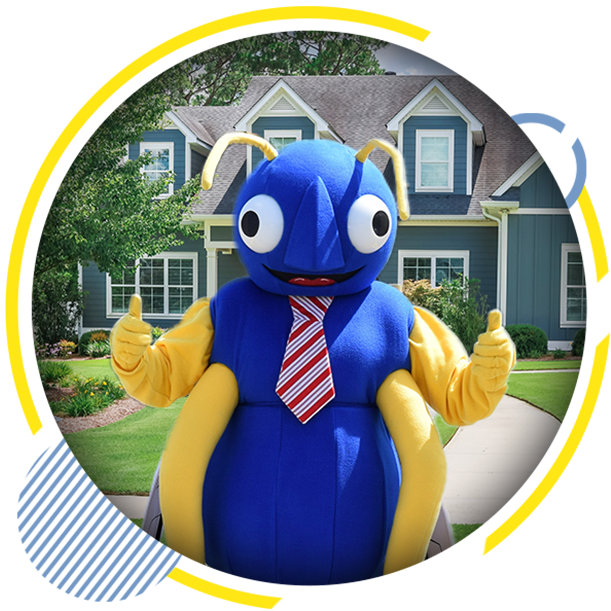
Carpenter Ants: The North's Version Of Termites
Throughout the Southern states, Formosan subterranean termites and Asian subterranean termites are incredibly destructive to properties. Those voracious creatures can completely wipe out the saving of a homeowner when they eat a home from the inside out. In New York, Connecticut, and even Massachusetts, the Eastern subterranean termite is a common property-damaging pest. This species of termite even does a little damage to homes in Southern Maine. But, for the most part, termites aren't a serious problem for Mainers. However, we have a pest that can give those termites a run for their money. It is called the carpenter ant; the North's version of termites.
Carpenter Ants Share Many Traits with Termites
Here are a few to take note of:
- Are you familiar with termite swarmers? They are termite alates that take to the air in spring and establish new nests. Carpenter ants do the same thing. While carpenter ants don't have wings, they do produce winged carpenter ants for the purpose of establishing new colonies.
- Are you aware that termites prefer soft or rotting wood? Carpenter ants do as well. When carpenter ants explore the foundation perimeter of a home, they will chew their way into old, rotting wood first. But, unlike termites, they won't stop at eating softwood. Carpenter ants are known to chew on harder wood as they expand their galleries.
- Do you know that termites are drawn to moisture? So are carpenter ants. Damp ground and moist wood will lure both of these pests to a home. If you have a gutter system that has debris in it, you could have a very damp foundation perimeter that is attractive to wood-damaging pests.
- Do you know that termites eat wood? While carpenter ants don't, that doesn't mean they aren't as destructive. The larger a colony is the more need there is for galleries. But, you may wonder, "Won't those carpenter ants need food and won't I see them when they start to get into my pantry or kitchen food packages?" Sadly, carpenter ants can find more food options outside of your home. One food source that is usually plentiful is honeydew created by aphids, scales, and other insects. If you have vegetation in your landscaping, it is likely that you have a food source for carpenter ants. They don't have to eat the food inside your home and alert you to their presence.
- Do you know that termites can damage the structures of a home? As termites feed on wood, it weakens the wood. This can put stress on other timbers and cause bending and warping to occur. Carpenter ants can do the same. The galleries created by carpenter ants are hard to distinguish from termites'. They look similar in appearance and are nearly as extensive.
- Do you see the picture? Carpenter ants are an important wood-destroying organism in Southern Maine. The only reason they don't do as much damage as Eastern subterranean termites do in more southern states is that they push sawdust out of their tunnels. When sawdust is seen, many homeowners realize that they have a problem and get it quickly addressed. Fast response to wood-destroying pests is the secret to preventing catastrophic damage. But carpenter ants don't always push sawdust out where you can see it. They may push it into a cellar or basement. They may push it into a room where you store firewood. They may push it into a room that is used for carpenter projects. Often, it is pushed into wall voids because carpenter ants prefer to be active in darkness. If you fail to see this sawdust, you could be in trouble.
Another sign carpenter ants give is often misunderstood. If you see carpenter ant swarmers crawling around on the outside of your Southern Maine home, this is not likely a sign of an impending infestation. It is more likely a sign of a current, active and mature infestation. This infestation may already be inside your home or it could be in an exterior structure, stump, log, tree, etc.
If you see signs of carpenter ants, reach out to Big Blue Bug Solutions immediately. We know how to track these destructive insects down and, more importantly, what is necessary to eliminate them.

chECK oUT THE bUZZ!
Unbeatable Pest Control, Unmatched Reviews
-
"They have exceeded expectations. Highly recommend."Alley Bergemann, called before arriving on the day of the appointment, showed up on time, and took care of re-baiting the bait traps as needed. She is patient, polite and answered a few questions I had, all with a pleasant demeanor.- Jonathan P.
-
"Always been amazed by the competence and professionalism of this company."
Their man, Elijah was a gentleman and very knowledgeable professional. He took the time to carefully listen to me when I explained where the ant infestation was found. He explained clearly what he was going to do to address the issue.
- Pete M. -
"GREAT company!"The Big Blue Bug Solutions is a GREAT company with very helpful, courteous technicians. This a company that actually helps you with your problems and not try to sell you something you don't need. I am very pleased, and NO, I have no relatives that work at- Robert M.
-
"Knowledgeable, accurate and incredibly pleasant."I just cannot believe the most amazing experience customer service experience I had with Laura who could not have been more knowledgeable, accurate and incredibly pleasant. It is very rare I leave a review but this encounter deserved one!- Kimberly H.
-
"Always very polite and accommodating."We’ve been using Big Blue Bug for pest control for many years and have been very satisfied! Vince visited today for our regular check in and he is an excellent technician. Thanks, BBB!- Stacey C.
-
"Knowledgeable, respectful, courteous!"
I highly recommend Big Blue Bug Solutions - first - for their customer service. They are professional and efficient and always try to fit me in at a time that is convenient for me. Second, RODNEY IS THE BEST TECHNICIAN!!!!
- Meredith L. -
"Our first service was a great experience!"Peter called to let us know he was on his way and arrived as scheduled. He was very knowledgeable and setup a comprehensive array of traps in each target area to begin capturing the pests and put an end to our troubles.- Mike H.
-
"Personable, friendly, and knowledgeable!"Shoutout to our tech, Jeremy Cote, who has been servicing our bakery in Richmond and has helped us maintain a pest free environment. He is personable, friendly, and knowledgeable. We highly recommend big blue bug to friends, family, and customers!- Becky M.


WE'RE AVAILABLE
EVERY DAY, ALL DAY,
365 DAYS A YEAR
Say goodbye to automated systems! Our team is at your service round the clock, every single day of the year, guaranteeing a personalized and immediate response to your queries.
